Problem: I have records with a start and end date for an intervention and I want to merge the rows according to the following rule:
For each ID, any intervention that begins within one year of the last intervention ending, merge the rows so that the start_date is the earliest start date of the two rows, and the end_date is the latest end_date of the two rows. I also want to keep track of intervention IDs if they are merged.
There can be five scenarios:
- Two rows have the same start date, but different end dates.
Start date....End date
Start date.........End date
- The period between row 2's start and end date lies within the period of row 1's start and end date.
Start date...................End date
.......Start date...End date
- Row 2's intervention starts within Row 1's intervention period but ends later.
Start date.....End date
.....Start date.............End date
- Row 2 starts within one year of the end of Row 1.
Start date....End date
......................|....<= 1 year....|Start date...End date
- Row 2 starts over one year after the end of Row 1.
Start date...End date
.....................|........ > 1 year..........|Start date...End date
I want to merge rows in cases 1 to 4 but not 5.
Data:
library(data.table)
sample_data <- data.table(id = c(rep(11, 3), rep(21, 4)),
start_date = as.Date(c("2013-01-01", "2013-01-01", "2013-02-01", "2013-01-01", "2013-02-01", "2013-12-01", "2015-06-01")),
end_date = as.Date(c("2013-06-01", "2013-07-01", "2013-05-01", "2013-07-01", "2013-09-01", "2014-01-01", "2015-12-01")),
intervention_id = as.character(1:7),
all_ids = as.character(1:7))
> sample_data
id start_date end_date intervention_id all_ids
1: 11 2013-01-01 2013-06-01 1 1
2: 11 2013-01-01 2013-07-01 2 2
3: 11 2013-02-01 2013-05-01 3 3
4: 21 2013-01-01 2013-07-01 4 4
5: 21 2013-02-01 2013-09-01 5 5
6: 21 2013-12-01 2014-01-01 6 6
7: 21 2015-06-01 2015-12-01 7 7
The final result should look like:
> merged_data
id start_date end_date intervention_id all_ids
1: 11 2013-01-01 2013-07-01 1 1, 2, 3
2: 21 2013-01-01 2014-01-01 4 4, 5, 6
3: 21 2015-06-01 2015-12-01 7 7
I'm not sure if the all_ids column is the best way to keep track of the intervention_id's so open to ideas for that. (The intervention_id's don't need to be in order in the all_ids column.)
It doesn't matter what the value of the intervention_id column is where rows have been merged.
What I tried:
I started off by writing a function to deal with only those cases where the start date is the same. It's a very non-R, non-data.table way of doing it and therefore very inefficient.
mergestart <- function(unmerged) {
n <- nrow(unmerged)
mini_merged <- data.table(id = double(n),
start_date = as.Date(NA),
end_date = as.Date(NA),
intervention_id = character(n),
all_ids = character(n))
merge_a <- function(unmerged, un_i, merged, m_i, no_of_records) {
merged[m_i] <- unmerged[un_i]
un_i <- un_i + 1
while (un_i <= no_of_records) {
if(merged[m_i]$start_date == unmerged[un_i]$start_date) {
merged[m_i]$end_date <- max(merged[m_i]$end_date, unmerged[un_i]$end_date)
merged[m_i]$all_ids <- paste0(merged[m_i]$all_ids, ",", unmerged[un_i]$intervention_id)
un_i <- un_i + 1
} else {
m_i <- m_i + 1
merged[m_i] <- unmerged[un_i]
un_i <- un_i + 1
merge_a(unmerged, un_i, merged, m_i, (no_of_records - un_i))
}
}
return(merged)
}
mini_merged <- merge_a(unmerged, 1, mini_merged, 1, n)
return(copy(mini_merged[id != 0]))
}
Using this function on just one id gives:
> mergestart(sample_data[id == 11])
id start_date end_date intervention_id all_ids
1: 11 2013-01-01 2013-07-01 1 1,2
2: 11 2013-02-01 2013-05-01 3 3
To use the function on the whole dataset:
n <- nrow(sample_data)
all_merged <- data.table(id = double(n),
start_date = as.Date(NA),
end_date = as.Date(NA),
intervention_id = character(n),
all_ids = character(n))
start_i <- 1
for (i in unique(sample_data$id)) {
id_merged <- mergestart(sample_data[id == i])
end_i <- start_i + nrow(id_merged) - 1
all_merged[start_i:end_i] <- copy(id_merged)
start_i <- end_i
}
all_merged <- all_merged[id != 0]
> all_merged
id start_date end_date intervention_id all_ids
1: 11 2013-01-01 2013-07-01 1 1,2
2: 21 2013-01-01 2013-07-01 4 4
3: 21 2013-02-01 2013-09-01 5 5
4: 21 2013-12-01 2014-01-01 6 6
5: 21 2015-06-01 2015-12-01 7 7
I also had a look at rolling joins but still can't get how to use it in this situation.
This answer https://stackoverflow.com/a/48747399/6170115 looked promising but I don't know how to integrate all the other conditions and track the intervention IDs with this method.
Can anyone point me in the right direction?
